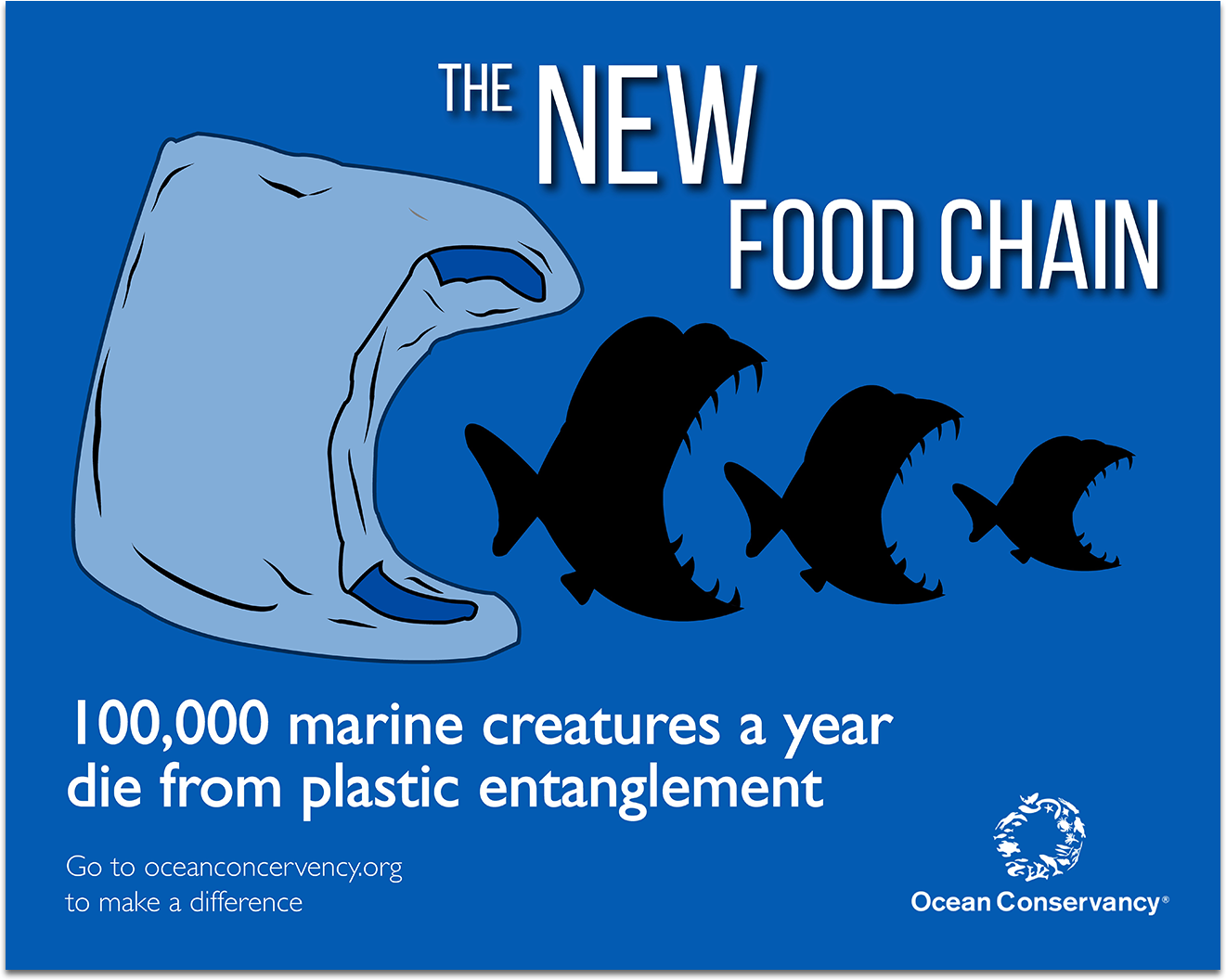Introduction
The plight of environmentalism has gained quite some traction over the past couple of decades, yet its message still needs further promotion. With the rise in consumerism and the emphasis on production volume rather than its ethics, global industries, as well as individual consumers, have contributed massively to a rise in environmental concerns, particularly, pollution (Sharma 79).
Ocean dumping is one of the core environment-related concerns presently (Sharma 78). Causing not only global-scale water pollution but also the destruction of lives and habitats of countless species, ocean dumping needs to be terminated, as the image by Ocean Conservancy demonstrates (see Fig. 1). By incorporating a smart visual that hints at the negative consequences of ocean pollution and the textual part that details the problem and its solution succinctly, the poster represents an ideal approach to building environmental awareness.
This analysis targets a general audience that needs a more nuanced perspective on ocean pollution. Due to the lack of creativity and nuance in which the issue has been addressed for decades, most people have developed a rather ironic attitude toward environmental PSAs (Sharma 88). Therefore, the goal of this paper is to prove that the poster in question manages to accomplish an impressive goal of subverting the audience’s expectation and encouraging them to shift from an ironic perception of the issue to a critical one.
Summary
In the image in question, a visual metaphor is depicted. From left to right, three fish attempting to eat each other are portrayed, with the largest one about to be devoured not by an even bigger fish but by an enormous plastic bag. The caption above reads, “The New Food Chain,” whereas below, statistical data is cited, followed by an invitation to the official site. The background color of the poster is blue, which makes the color scheme outstandingly simple, with only three colors (blue, white, and black) used. The organization’s logo is represented in the lower right corner.

Visual Components
The image strikes with its visual simplicity and the effectiveness of its message. First and most obvious, the visual metaphor has been crafted with outstanding mastery and an incredible understanding of the target audience. The metaphor of the plastic bag becoming the supposed top of the food chain by causing the deaths of multiple species and creating a very tangible threat of their possible extinction is an outstanding use of visuals.
Due to the use of simple and easily recognizable imagery, the metaphor is easily understandable and translatable into any language or culture., thus, targeting the global audience. The simple three-color palette keeps the viewer’s attention on the visual components, whereas the choice of the font size, shape, and location allows zooming in on the essential information and directing the viewer to the further data, thus, creating a powerful call for action.
Rhetorical Appeals
In turn, the appeal of the textual part of the poster is also immense. Specifically, the ethos of the textual part of the image in question is quite apparent. Having introduced a biting metaphor of water pollution becoming the unhinged creature that devours other species, the authors of the poster have established an ethical argument of ocean dumping being the direct product and, therefore, responsibility of the humankind. The fact that the specified statement is written in the largest fond also established the collective responsibility for the specified issue.
Likewise, the pathos is also transparent in the text. Namely, by positioning the humankind and ocean dumping that it has been encouraging as the aggressive beast that targets other creatures, the text elicits a significant amount of empathy toward vulnerable species. Furthermore, by mentioning the deaths and extinction of species directly, the textual part of the image makes the viewer empathize with innocent ocean dwellers. Therefore, the pathos functions remarkably well even without directly appealing to feelings and, instead, providing statistics and facts.
Finally, the logos of the text in the image also serves the purpose of convincing the audience to contribute to saving the ocean. Namely, the statistical data mentioned earlier coupled with the call to action creates a compelling message and an impetus for changing the situation. In addition, the different size of the key textual parts introduces the order in which the viewer perceives the message, thus, establishing the urgency of the issue, determining the solution, and encouraging the viewer to act. Therefore, every element of the text works perfectly and has its unique function.
Conclusion
Due to the combination of a visual metaphor that manages to be both straightforward and not annoying, as well as the clear and accurate summary of the problem and its solution, the Ocean Conservancy poster offers a perfect example of environmental campaigning. The picture captures the attention of its viewers immediately due to the smart and easily perceivable drawing, while the textual part is arranged in the way that elicits a range of emotions. Finally, the textual part concludes with the suggestion of a solution, which is perceived as a powerful call to action. Therefore, the visuals and the textual parts of Ocean Conservation’s poster deserve to be regarded as a stellar example of an environmental PSA.
Works Cited
Sharma, Akanksha. “The Disregarded Dilemma of Ocean Dumping.” Supremo Amicus, vol. 18, 2020, pp. 78-91.
The New Food Chain. OceanConservancy. Web.